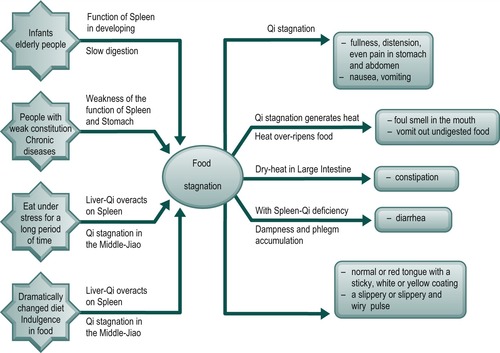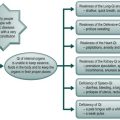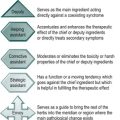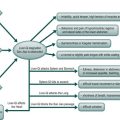Chapter Eight. Syndrome of food accumulation and formula composition
CHAPTER CONTENTS
CHAPTER OUTLINE
This chapter introduces the principles, methods and strategies for the composition of formulas that promote digestion and dissolve accumulated food. They are used to treat the syndrome of food accumulation.
Although food accumulation is not commonly seen nowadays in developed countries, food accumulation might still occur in certain situations:
• It may occur in infants, since their Spleen and Stomach are not fully developed and the parents may lack experience or knowledge of the best way to feed and nurse their child.
• It also happens among elderly people since their digestion is slower than before.
• It can arise in people with a weak constitution, patients who suffer from chronic diseases, people who have been eating under stress for a long period of time, and people who change their diet dramatically. Because their Spleen and Stomach are not strong, food can easily become stagnant in the Middle-Jiao.
• Acute cases can sometimes occur in the vacation period when the diet is changed significantly, or among people who overindulge in food.
Syndrome of food accumulation
Manifestations
Main symptoms
Fullness in the stomach, belching, nausea, vomiting with a foul smell, distending pain in the abdomen, constipation or diarrhea.
Secondary symptoms
Chronic indigestion, poor appetite, distension of abdomen, particularly after meals or after taking heavy, unfamiliar food, impairment of general condition and development in children.
Tongue
Normal tongue with a white or slightly yellow sticky coating.
Pulse
Slippery, forceful and rapid.
Associated disorders in western medicine
Acute or chronic diseases and disorders of the digestive system and the immune system, such as chronic gastric ulcer, duodenal ulcer, irritable bowel syndrome, food allergy and intolerance.
Analysis of the syndrome
Proper digestion depends on the cooperation of the Stomach and Spleen. In the Middle-Jiao, the Stomach-Qi moves downwards and the organ receives and ripens food; the Spleen-Qi moves upwards and the organ transforms the food into Qi and blood, which are further transported to the Lung. Through the dispersing function of the Lung, Qi and blood spread throughout the entire body.
• When food accumulates in the Stomach, the Qi in the Middle-Jiao is blocked. Patients may feel fullness and distension, sometimes with pain in the stomach and abdomen.
• When Stomach-Qi fails to descend, nausea and vomiting may occur.
• Since the Stomach is a Yang Ming organ, it is active in ripening food with its Yang and heat. When the Qi is blocked, heat can over-ripen the food, which leads to foul breath, and patients may vomit undigested food.
• The Large Intestine is a Yang Ming organ; constipation may present when there is dry-heat there.
• In a chronic condition, particularly when the Qi is too weak to ascend to transform the food into essence, dampness may accumulate and phlegm may be formed, which leads to diarrhea.
• When food accumulation is in an acute stage, the color of the tongue is almost normal; however, it will turn dark if the accumulation becomes chronic. The thickness of the tongue coating indicates the degree of accumulation; a yellow tongue coating indicates the degree of heat in the Stomach; sticky indicates the accumulation of dampness and phlegm of the Spleen. As to the pulse, a slippery, forceful and rapid pulse indicates an excess condition of accumulation; a wiry pulse indicates pain and tension in the Middle-Jiao; a thready pulse suggests deficiency.
(See Figure 8.1 on page 232.)
Treatment principle: Promote food digestion, regulate the Qi in the Middle-Jiao and strengthen the Spleen
Herb selection principles and formula composition strategies
• First, herbs that enter the Stomach and Spleen meridians, and have the function of promoting digestion are selected.
• Second, herbs that regulate the Qi movement and water metabolism in the Middle-Jiao, remove dampness and phlegm and thereby enhance the ability of the herbs that promote food digestion are selected.
• Herbs that tonify the Spleen-Qi, clear heat and warm the Spleen are often selected according to treatment need.
Note
• Formulas that treat food accumulation and formulas that drain downwards have similarities in application. Both treat accumulation and they both descend the Qi in the Stomach and intestines.
• Formulas that reduce food accumulation are relatively gentle. The purpose of the treatment is to dissolve the accumulation gradually, and they are used for mild accumulations.
• Formulas that drain downwards can powerfully stimulate the intestines and purge the accumulation. These formulas are strong, and the purpose is to guide out the accumulation vigorously and quickly in a very short time.
CAUTIONS
1. Choose a short treatment course for acute and excess accumulation:
Because formulas that reduce food accumulation can digest and dissolve food and phlegm, they can also injure the Stomach, Spleen, Qi and blood. They are usually only used for a short period of time. When the accumulated food has been digested, these formulas should be stopped.
2. Caution in pregnancy:
Formulas that remove food accumulation should be used with caution during pregnancy as they contain a number of herbs that activate Qi movement to remove food, phlegm and dampness.
3. Pay attention to the condition of the Spleen and Stomach in chronic cases:
Formulas that remove food accumulation are suitable for excess and acute conditions. In a condition of chronic food accumulation, among people who have deficiency of the Spleen and Stomach, a formula with tonifying herbs should be used for a long period of time, together with gentle herbs that promote digestion.
4. Avoid sweet food and herbs:
Sweet food and herbs should be avoided as they can increase the dampness in the Middle-Jiao in a condition of food accumulation. Furthermore, they make the dampness accumulation worse and patients may easily feel nauseous.
5. Follow an appropriate diet:
During treatment, patients should take soft, gentle and warm foods, which are easily digested while being rich in nutrition. After recovery, appropriate dietary advice should be given to patients according to the digestive capacity of each individual.
Structure of the formula and selection of herbs
Chief: Reduce food accumulation and aid the digestion
Mai Ya ( Hordei fructus germinatus), Shen Qu ( Massa medicata fermentata) and Shan Zha ( Crataegi fructus)
These three herbs have the function of promoting digestion. Since they are often used together and are very effective in treating food stagnation, they have another name – Jiao San Xian; Jiao means deep dry-fried, San means three and Xian means immortal. In other words, it means three very effective herbs. These herbs are often deeply dry-fried until their colors change to deep brown, based on the belief that this makes them easier to digest. They work particularly on the Middle-Jiao.
These three herbs are often used together because their different functions can enhance each others’ therapeutic effects. Mai Ya is sweet and neutral, and enters the Spleen and Stomach meridians. It especially aids the digestion of wheat, rice and fruits. Shen Qu is pungent, sweet and warm, and enters the Spleen and Stomach meridians. It particularly aids the digestion of grains and dispels the effects of alcohol. Shan Zha is sour, sweet and slightly warm, and enters the Spleen, Stomach and Liver meridians. It especially aids the digestion of meat, fat and milk. In most cases of food stagnation these kinds of food and drink are all involved, hence these herbs are often used together.
Lai Fu Zi ( Raphani semen) and Ji Nei Jin ( Gigeriae galli endothelium corneum)
Lai Fu Zi is pungent, sweet and neutral, and enters the Lung and Spleen meridians. Lai Fu Zi is a strong herb to remove food accumulation. In addition, it can descend the Lung-Qi, soothe the Stomach-Qi and promote bowel movement. It can also eliminate phlegm in either the Lung or the Stomach.
Ji Nei Jin is sweet and slightly cold, and enters the Stomach, Spleen and Bladder meridians. It aids digestion of all kinds of food. Its function is quite strong. Since it is cold in temperature, it is also able to reduce heat and eliminate irritability. It is particularly suitable for use in children with malnutrition when chronic food stagnation has already produced heat.
Deputy: Regulate the Qi in the Middle-Jiao and remove dampness and phlegm
Ban Xia ( Pinelliae rhizoma) and Chen Pi ( Citri reticulatae pericarpium)
Ban Xia and Chen Pi are often used to regulate the Qi in the upper abdomen and reduce Qi stagnation, thus accelerating the transformation and transportation of food and drink in the Middle-Jiao. They can soothe the Stomach-Qi and treat nausea and fullness of the stomach.
Mu Xiang ( Aucklandiae radix)**, Bing Lang ( Arecae semen) and Sha Ren ( Amomi xanthioidis fructus)
Mu Xiang and Bing Lang can regulate the Qi in the lower abdomen and reduce distension. They can accelerate food transformation and transportation in the Middle-Jiao. They can treat constipation and diarrhea.
Sha Ren is pungent, aromatic and warm. It can effectively regulate the Qi as well as transform dampness in the abdomen and improve digestion. It is often used for treating abdominal distension.
Hou Po ( Magnoliae cortex)
Hou Po is pungent, warm and bitter, and enters the Spleen, Stomach, Large Intestine and Lung meridians. It can effectively regulate the Qi in the chest and the whole abdomen, and reduce distension. It can also remove phlegm and dampness.
Assistant: Tonify the Spleen-Qi and strengthen the Middle-Jiao
Bai Zhu ( Atractylodis macrocephalae rhizoma)
Bai Zhu is sweet and warm, and can tonify the Spleen-Qi. However, as it is also bitter and warm, it can dry dampness. It is used to treat chronic food accumulation caused by Spleen-Qi deficiency where poor appetite, diarrhea and distension of the stomach and abdomen may exist.
Fu Ling ( Poria)
Fu Ling is neutral and bland. It can gently tonify the Spleen-Qi and eliminate dampness in the Middle-Jiao. Its function is gentle and it can be used for a long period of time. It is suitable for use in chronic food accumulation and mild Spleen-Qi deficiency.
Fu Ling can also tonify the Heart-Qi and is therefore used for calming the mind. It is particularly useful for children with mild Heart-Qi and Spleen-Qi deficiency who suffer from restless sleep due to food accumulation.
Ren Shen ( Ginseng radix), Huang Qi ( Astragali radix) and Dang Shen ( Codonopsis radix)
Ren Shen and Huang Qi are strong herbs to tonify the Spleen-Qi and promote digestion. They are used for severe cases of deficiency of Spleen-Qi, especially in chronic conditions. A large dosage of Dang Shen is often used as a substitute for Ren Shen.
Huang Lian ( Coptidis rhizoma) and Lian Qiao ( Forsythiae fructus)
Huang Lian is bitter and cold. Bitterness can descend the Qi and cold can clear fire. It is believed that a small amount of this bitter and cold herb can strengthen the function of the Stomach where the heat easily accumulates.
Lian Qiao is also bitter and cold. However, it has fragrant smell and thus not only descends the Qi and clears the heat, but also disperses the restrained heat that is produced by food accumulation.
Envoy: Harmonize the herbs in the whole formula in the aspects of temperature, taste, working directions and levels, and characteristics
Since all of the chief herbs enter the Spleen meridian and promote digestion, it is not necessary to use a guide herb.
Common accompanying symptoms and treatment
• Nausea and vomiting with a foul smell: use Ban Xia ( Pinelliae rhizoma), Huang Qin ( Scutellariae radix) and Zhu Ru ( Bambusae caulis in taeniam) to soothe the Stomach-Qi and clear the heat.
• Bitter taste in the mouth with a foul smell: use Huang Lian ( Coptidis rhizoma) or Lian Qiao ( Forsythiae fructus) to reduce the heat from the accumulation of food.
• Constipation: use Da Huang ( Rhei rhizoma) to purge the intestines and use Mai Men Dong ( Ophiopogonis radix) to moisten the intestines.
• Stomach fullness due to stress and emotional disturbance: use Chai Hu ( Bupleuri radix), Fo Shou ( Citri sarcodactylis fructus) and Xiang Yuan ( Citri fructus) to regulate the Liver and Stomach.
• Burning pain in the stomach due to Stomach-heat and Liver-heat: add Dan Shen ( Salviae miltiorrhizae radix), Huang Lian ( Coptidis rhizoma) and Mei Gui Hua ( Rosae flos) to reduce heat and regulate the Qi.
• Loose stool without smell, sensitivity to heavy food, bloating and defecation with wind: add Fang Feng ( Saposhnikoviae radix), Jing Jie ( Schizonepetae herba) and Bai Zhu ( Atractylodis macrocephalae rhizoma) to regulate the function of the intestines.
• Cold sensation in the Stomach with cramping pain: use Zi Su Ye ( Perillae folium) and Sheng Jiang ( Zingiberis rhizoma recens) to warm and ease the Stomach.
• Poor appetite, malnutrition in children: use Bai Zhu ( Atractylodis macrocephalae rhizoma) and Hu Huang Lian ( Picrorhizae rhizoma) to promote digestion.
Examples of classical formulas
Bao He Wan (Preserve Harmony Pill) 
Source: Dan Xi Xin Fa 
Composition
Shan Zha ( Crataegi fructus) 180 g
Shen Qu ( Massa medicata fermentata) 60 g
Lai Fu Zi ( Raphani semen) 30 g
Chen Pi ( Citri reticulatae pericarpium) 30 g
Ban Xia ( Pinelliae rhizoma) 90 g
Fu Ling ( Poria) 90 g
Lian Qiao ( Forsythiae fructus) 30 g
Analysis of the formula
This formula can promote digestion and regulate Qi movement in the Middle-Jiao. It is used to treat acute food stagnation when the Qi is blocked and slight heat is generated. The manifestations are fullness in the stomach, belching, nausea, vomiting with a foul smell, distending pain in the abdomen, constipation or diarrhea. The tongue body is normal or slightly red, and the coating is thick, white or slightly yellow. The pulse is slippery, forceful and rapid.
In the formula:
• Shan Zha, Shen Qu and Lai Fu Zi are used as chief. They are used together to promote digestion of all types of food. Lai Fu Zi also descends the Qi and removes food and phlegm.
• Chen Pi and Ban Xia serve as deputies. They soothe the Stomach-Qi, promote digestion and improve appetite, thus enhancing the ability of the chief herbs and treating Qi stagnation caused by food accumulation.
• Fu Ling is used as assistant. It tonifies the Spleen-Qi, removes the dampness, stops diarrhea and calms the mind. Lian Qiao, another assistant, can disperse and clear the heat that is produced by food accumulation. Together with Fu Ling, Lian Qiao calms the mind and relieves irritability due to uneasy sensations in the stomach.
Commentary on strategies
Lian Qiao is used in this formula although there is no obvious sign of heat. If the accumulation happens in the Yang organ, the Stomach, and it is impossible to reduce the accumulation quickly, logically the accumulation will surely generate heat. To prevent heat generation, therefore, Lian Qiao is used in a smart way in the formula.
Zhi Shi Dao Zhi Wan (Immature Bitter Orange Pill to Guide Out Stagnation) 
Source: Nei Wai Shang Bian Huo Lun 
Composition
Da Huang ( Rhei rhizoma) 30 g
Zhi Shi ( Aurantii fructus immaturus) 15 g
Shen Qu ( Massa medicata fermentata) 15 g
Huang Lian ( Coptidis rhizoma) 9 g
Huang Qin ( Scutellariae radix) 9 g
Fu Ling ( Poria) 9 g
Ze Xie ( Alismatis rhizoma) 6 g
Bai Zhu ( Atractylodis macrocephalae rhizoma) 9 g
Analysis of the formula
This formula treats not only food accumulation, but also a severe complicated condition of food and damp-heat accumulation in the intestines. The manifestations are abdominal distension and pain, foul-smelling diarrhea, constipation and scanty urine. The tongue is red with a yellow and sticky coating. The pulse is deep and firm.
In this formula:
• Da Huang is used as chief with a large dosage to purge the intestines and remove the accumulation.
• Zhi Shi, as deputy, descends the Qi in the intestines, reduces distending pain and enhances the function of the chief.
• The remaining herbs are used as assistants to remove the accumulation and strengthen the Middle-Jiao:
– Shen Qu aids digestion and dissolves food accumulation.
– Huang Qin and Huang Lian are able to clear damp-heat and treat diarrhea and abdominal pain.
– Fu Ling and Ze Xie are able to leach out dampness and stop diarrhea.
– Bai Zhu and Fu Ling can strengthen the function of the Spleen, dry the dampness in the Middle-Jiao and enhance the ability of herbs that remove the accumulation. They also serve as corrective assistant as they can protect the Spleen and Stomach from bitter and cold herbs, such as Huang Lian and Huang Qin, as well as the harsh action of Da Huang.
Commentary on strategies
• In this formula, herbs are used in groups to treat accumulation of food, dampness and heat.
• The action of intense reducing herbs is balanced by using tonifying herbs.
• These strategies are effective in treating a quite severe but complicated condition of accumulation.
Jian Pi Wan (Strengthen the Spleen Pill) 
Source: Zheng Zhi Zuen Sheng 
Composition
Chao Bai Zhu (dry-fried Atractylodis macrocephalae rhizoma) 75 g
Fu Ling ( Poria) 60 g
Ren Shen ( Ginseng radix) 45 g
Shan Yao ( Dioscoreae rhizoma) 30 g
Rou Dou Kou ( Myristicae semen) 30 g
Shan Zha ( Crataegi fructus) 30 g
Chao Shen Qu (dry-fried Massa medicata fermentata) 30 g
Chao Mai Ya (dry-fried Hordei fructus germinatus) 30 g
Mu Xiang ( Aucklandiae radix)** 22.5 g
Chen Pi ( Citri reticulatae pericarpium) 30 g
Sha Ren ( Amomi xanthioidis fructus) 30 g
Jiu Zhi Huang Lian (wine-fried Coptidis rhizoma) 22.5 g
Gan Cao ( Glycyrrhizae radix) 22.5 g
Analysis of the formula
This formula is able to strengthen the Spleen, reduce food stagnation and promote digestion. It is used for food stagnation due to weakness of the Spleen. The manifestations are reduced appetite, bloating and focal distension of the epigastria and abdomen, belching, soft stool or diarrhea. The tongue is slightly pale with teeth marks and the coating is slightly yellow and sticky. The pulse is weak.
In this formula:
• Bai Zhu is used in a large dosage as chief to tonify the Spleen-Qi, dry the dampness and thereby promote digestion.
• There are two groups of deputies: Ren Shen, Shan Yao and Fu Ling tonify the Spleen and strengthen the function of Bai Zhu; Mai Ya, Shen Qu and Shan Zha resolve food accumulation and aid digestion.
• There are three groups of assistants:
– Rou Dou Kou is warm and pungent. It warms the Middle-Jiao, dries dampness and promotes digestion; together with Shan Yao it can also stop diarrhea.
– Mu Xiang, Chen Pi and Sha Ren are able to reduce food accumulation through activating the Qi movement in the Stomach and Large Intestine. They can also reduce the cloying and heavy nature of the tonifying herbs.
– Huang Lian is used for reducing constrained heat produced by the accumulation.
• Gan Cao is sweet in nature and enters the Spleen meridian. It is used as envoy to harmonize the herbs in the formula.
Commentary on strategies
• In this formula, herbs that strengthen the Spleen, reduce food stagnation and promote digestion are used together.
• The herb selection is very sensible and the processing procedures suit the weak and sensitive Stomach and Spleen. Bai Zhu, Mai Ya and Shen Qu are all dry-fried. After this processing, they particularly enter the Spleen and their function of promoting digestion is more effective. Huang Lian is processed by alcohol because alcohol can reduce its cold nature, thus avoiding the likelihood of injuring a weak and sensitive Stomach. Alcohol can also disperse heat from the accumulation in the Stomach. Rou Dou Kou is covered with pasta and gently baked, thus removing the oil in this herb which may cause diarrhea.
Zhi Zhu Wan (Immature Bitter Orange and Atractylodes Macrocephala Pill) 
Source: Nei Wai Shang Bian Huo Lun 
Composition
Bai Zhu ( Atractylodis macrocephalae rhizoma) 60 g
Zhi Shi ( Aurantii fructus immaturus) 30 g
Pills made from the above two herbs should be taken with He Ye ( Nelumbinis folium) tea, 2 g dissolved in 50 ml of hot water, up to a total dosage of He Ye of 6–9 g.
Analysis of the formula
This formula can strengthen the Spleen and dissolve the food accumulation. It is used to treat poor appetite, fullness in the stomach and weakness of the muscles due to malnutrition. It is particularly used for children who have impaired digestion.
This is a small formula that is formed with two herbs:
• Bai Zhu is used as chief in a large dosage to tonify the Spleen-Qi and promote digestion.
• Zhi Shi is used as deputy to descend the Qi in the Stomach and intestines, remove the accumulation and reduce distension.
Commentary on strategies
Although this formula is very small in size, it clearly shows the way to reduce food accumulation in a chronic condition when the Spleen-Qi is not strong.
• In the formula, tonifying and reducing herbs are used together. The dosage of the tonifying herb is much greater than that of the reducing herb, indicating the emphasis of the formula.
• This formula is used in pill form, which is particularly suitable for chronic conditions and is less irritating to a weak and sensitive stomach.
• Moreover, the pills are taken with He Ye tea, which has a fragrant smell, can ascend the clear Qi of the Spleen and promote digestion. This tea is easily accepted by children.
 |
| Figure 8.1 •. |
| Etiology and pathology of food accumulation syndrome. |




